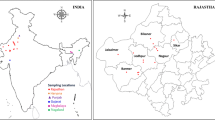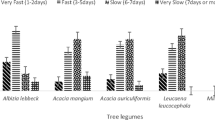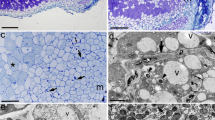Abstract
Aims
To survey the occurrence of nodulated legumes in the arid and semi-arid areas of Western Rajasthan and to characterize their associated symbiotic bacteria.
Methods
Herbaceous annual species were excavated whole, while tree species were studied as seedlings in the field or as trap plants in pot experiments. Nodules were examined by microscopy to confirm their effectiveness and to determine their internal structure. Bacteria isolated from the nodules were authenticated on their original hosts and were identified on the basis of 16S rRNA sequencing. Phylogenetic trees were inferred using the neighbour-joining method.
Results
We studied 35 of more than 50 species of native legume reported from these areas. Legumes are drought escaping (annual species), drought tolerant perennials or trees possessing deep root systems and other adaptations to arid conditions. Nodulation was recorded in all members of the Papilionoideae and Mimosoideae, but only one species of Caesalpinioideae. Internal structure of nodules varied within these groups, especially with respect to the presence or absence of uninfected cells in the infected region. Full 16S rRNA gene sequencing revealed that the nodules harboured a range of nodulating bacteria belonging to the genera Sinorhizobium, Rhizobium and Bradyrhizobium, within which they formed separate sub clades.
Conclusions
This study extends the range of legumes known to grow and nodulate in semi-arid regions, and provides information about their endosymbionts.





Similar content being viewed by others
References
Altschul SF, Gish W, Miller W, Myers EW, Lipman DJ (1990) Basic local alignment search tool. J Mol Biol 215:403–410
Ba S, Willems A, de Lajudie P, Roche P, Jeder H, Quatrini P, Neyra M, Ferro M, Promé JC, Gillis M, Boivin-Masson C, Lorquin J (2002) Symbiotic and taxonomic diversity of rhizobia isolated from Acacia tortilis ssp. raddiana in Africa. Syst Appl Microbiol 25:130–145
Benata H, Mohammed O, Noureddine B, Abdelbasset B, Abdelmoumen H, Muresu R, Squartini A, El Idrissi MM (2008) Diversity of bacteria that nodulate Prosopis juliflora in the eastern area of Morocco. Syst Appl Microbiol 31:378–386
Bhandari MM (1990) Flora of the Indian desert. MPS Repros, Jodhpur
Crisp M, Cook L, Steane D (2004) Radiation of the Australian flora: what can comparisons of molecular phylogenies across multiple taxa tell us about the evolution of diversity across multiple plant lineages. Phil Trans Roy Soc London B 359:1551–1171
Deng ZS, Zhao LF, Kong ZY, Yang WQ, Lindstrom K, Wang ET, Wei GH (2011) Diversity of endophytic bacteria within nodules of the Sphaerophysa salsula in different regions of Loess Plateau in China. FEMS Microbiol Ecol 76:463–475
Dhir RP (1977) Western Rajasthan soils, their characteristics and properties. In desertification and its control, ICAR 102–115
Doignon-Bourcier F, Williams A, Coopman R, Laguerre G, Gillis M, de Lajudie P (2000) Genotypic characterization of Bradyrhizobium strains nodulating small Senegalese legumes by 16S-23S rRNA intergenic gene spacers and amplified fragment length polymorphism fingerprinting analyses. Appl Environ Microbiol 66:3987–3997
dos Reis FB Jr, Simon MF, Gross E, Boddey RM, Elliott GN, Neto NE, Loureiro Mde F, de Queiroz LP, Scotti MR, Chen W-M, Noren A, Rubio MC, de Faria SM, Bontemps C, Goi SR, Young JPW, Sprent JI, James EK (2010) Nodulation and nitrogen fixation by Mimosa spp. in the Cerrado and Caatinga biomes of Brazil. New Phytol 186:934–946
Du Puy DJ, Labat VN, Rabevohitia R, Villiers J-F, Bosser V, Moat J (2002) The Leguminosae of Madagascar. Royal Botanic Gardens, Kew
Fall D, Diouf D, Ourarhi M, Faye A, Abdelmounen H, Neyra M, Sylla SN, El Idrissi MM (2008) Phenotypic and genotypic characteristics of Acacia senegal (L.) Willd. root-nodulating bacteria isolated from soils in the dryland part of Senegal. Lett Appl Microbiol 47:85–97
Garau G, Yates RJ, Deiana P, Howieson JG (2009) Novel strains of nodulating Burkholderia have a role in nitrogen fixation with herbaceous legumes adapted to acid, infertile soils. Soil Biol Biochem 41:125–135
Gaunt MW, Turner SL, Rigottier-Gois L, Lloyd-Macgilp SA, Young JPW (2001) Phylogenies of atpD and recA support the small subunit rRNA-based classification of rhizobia. Int J Syst Evol Microbiol 51:2037–2048
Hou BH, Wang ET, Li Y, Jia RZ, Chen WF, Man CX, Sui XH, Chen WX (2009) Rhizobial resource associated with epidemic legumes in Tibet. Microb Ecol 57:69–81
Howieson J, Ewing M, D’Antuono M (1988) Selection for acid tolerance in Rhizobium meliloti. Plant Soil 105:179–188
Jackson ML (1973) Soil chemical analysis. Prentice Hall of India Pvt Ltd, New Delhi
James EK, Loureiro M de F, Pott A, Pott VJ, Martins M, Franco AA, Sprent JI (2001) Flooding tolerant legume symbioses from the Brazilian Pantanal. New Phytol 150:733–738
Jürgens N, Schmiedel U, Hoffman MT (2010) Biodiveristy in Southern Africa, vol 1. Klaus Hess, Hamburg
Kimura M (1980) A simple method for estimating evolutionary rate of base substitutions through comparative studies of nucleotide sequences. J Mol Evol 16:111–120
Kumar S, Sane PV (2003) Legumes of South Asia: a check list. Royal Botanic Gardens, Kew
Lewis G, Schrire B, Mackinder B, Lock M (2005) Legumes of the world. Royal Botanic Gardens, Kew
Miller AG, Morris M (2004) Ethnoflora of the Soqotra archipelago. Royal Botanic Gardens, Edinburgh
Naisbitt T, James EK, Sprent JI (1992) The evolutionary significance of the genus Chamaecrista as determined by nodule structure. New Phytol 122:187–192
Nick G, de Lajudie P, Eardly BD, Soumalainen S, Paulin L, Zhang X, Gillis M, Lindström K (1999) Sinorhizobium arboris sp. nov. and Sinorhizobium kostiense sp. nov., isolated from leguminous trees in Sudan and Kenya. Int J Syst Bacteriol 49:1359–1368
Odee DW, Sutherland JM, Makatiani ET, McInroy SG, Sprent JI (1997) Phenotypic characterization and composition of rhizobia associated with woody legumes growing in diverse Kenyan conditions. Plant Soil 188:65–75
Olsen SR, Cole CV, Watanabe FS, Dean LA (1954) Estimation of available phosphorus in soils by extraction with sodium bicarbonate. US department of Agriculture, Circular, pp 939
Pratt PF (1982) Potassium. In: Page AL, Miller RH, Keeny DR (eds) Methods of Soil Analysis Part II chemical and microbiological properties. Madison, Wisconsin, USA, pp 225–246
Räsänen IA, Sprent JI, Lindström K (2001) Symbiotic properties of sinorhizobia from Acacia and Prosopis nodules in Sudan and Senegal. Plant Soil 235:193–210
Ray Choudhury SP, Agarwal RK, Gupta NK, Thomas PK (1963) Soils of India. ICAR, New Delhi, p 495
Richards LA (1954) Diagnosis and improvements of saline and alkali soils. Agricultural Handbook No. 60, USDA, Washington, D. C.
Richardson AE, Viccars LA, Watson JM, Gibson AH (1995) Differentiation of Rhizobium strains using the polymerase chain reaction with random and directed primers. Soil Biol Biochem 27:515–524
Romdhane SB, Nasr H, Samba-Mbaye R, Neyra M, Ghorbal MH, De Lajudie P (2006) Genetic diversity of Acacia tortilis ssp. raddiana rhizobia in Tunisia assessed by 16S and 16S-23S rDNA genes analysis. J Appl Microbiol 100:436–445
Saitou N, Nei M (1987) The neighbor-joining method: a new method for reconstructing phylogenetic trees. Mol Biol Evol 4:406–425
Sanjappa M (1992) Legumes of India. Bisan Singh Mahendra Pal Singh, Dehra Dun
Schimel DS (2010) Dry lands in the earth system. Science 327:418–419
Schrire BD, Lewis GP, Lavin M (2005) Biogeography of the Leguminosae. In: Lewis G, Schrire B, Mackinder B, Lock M (eds) Legumes of the world. Royal Botanic Gardens, Kew, pp 21–54
Somasegaran PS, Hoben HJ (1994) Handbook for Rhizobia. Springer, New York
Sprent JI (2001) Nodulation in legumes. Royal Botanic Gardens, Kew
Sprent JI (2007) Evolving ideas of legume evolution and diversity: a taxonomic perspective on the occurrence of nodulation. New Phytol 175:11–25
Sprent JI (2009) Legume nodulation: a global perspective. Wiley-Blackwell, Oxford
Sprent JI, Gehlot HS (2010) Nodulated legumes in arid and semi-arid environments: are they important? Plant Ecol Divers 3:211–219
Tamura K, Peterson D, Peterson N, Stecher G, Nei M, Kumar S (2011) MEGA5: Molecular Evolutionary Genetics Analysis using maximum likelihood, evolutionary distance, and maximum parsimony methods. Mol Biol Evol 28:2731–2739
Thompson JD, Gibson TJ, Plewniak F, Jeanmougin F, Higgins DG (1997) The CLUSTAL X windows interface: flexible strategies for multiple sequence alignment aided by quality analysis tools. Nucleic Acids Res 25:4876–4882
Vincent JM (1970) A manual for the practical study of root nodule bacteria. Blackwell Scientific, Oxford
Walkley A, Black CA (1934) An examination of Degtijareff methods for determining soil organic matter and a proposed modification of the chromic acid titration method. Soil Sci 37:29–38
Weisburg WG, Barns SM, Pelletier DA, Lane DJ (1991) 16S Ribosomal DNA amplification for phylogenetic study. J Bacteriol 173:697–703
Wolde-meskel E, Berg T, Peters NK, Frostegård A (2004) Nodulation status of native woody legumes and phenotypic characteristics of associated rhizobia in soils of southern Ethiopia. Biol Fertil Soils 40:55–66
Yanagi M, Yamasato K (1993) Phylogenetic analysis of the family Rhizobiaceae and related bacteria by sequencing of 16S rRNA gene using PCR and DNA sequencer. FEMS Microbiol Lett 107:115–120
Yates RJ, Howieson JG, Nandasena KG, O’Hara GW (2004) Root-nodule bacteria from indigenous legumes in the north-west of Western Australia and their interaction with exotic legumes. Soil Biol Biochem 36:1319–1329
Yates RJ, Howieson JG, Reeve WG, Nandasena KG, Law IJ, Brau L, Ardley JK, Nistelberger HM, Real D, O’Hara GW (2007) Lotononis angolensis forms nitrogen fixing, lupinoid nodules with phylogenetically unique, fast growing, pink-pigmented bacteria, which do not nodulate L. bainesii or L. listii. Soil Biol Biochem 39:1680–1688
Zahran HH (2001) Rhizobia from wild legumes: diversity, taxonomy, ecology, nitrogen fixation and biotechnology. J Biotechnol 91:43–53
Zakhia F, Jederz H, Domerguei O, Willems A, Cleyet-Mareh J-C, Gillis M, Dreyfus B, de Lajudie P (2004) Characterisation of wild legume nodulating bacteria (LNB) in the infra-arid zone of Tunisia. Syst Appl Microbiol 27:380–395
Zakhia F, Jederz H, Domerguei O, Willems A, Cleyet-Mareh J-C, Gillis M, Dreyfus B, de Lajudie P (2006) Diverse bacteria associated with root nodules of spontaneous legumes in Tunisia and first report for nifH-like gene within the genera Microbacterium and Starkeya. Microb Ecol 51:375–393
Acknowledgments
Dheeren Panwar, Indu S. Sankhla, Neetu Poonar and Nisha Tak would like to thank the University Grants Commission (UGC) and Council of Scientific and Industrial Research (CSIR) for financial assistance in the form of a junior research fellowship, while Alkesh Tak acknowledges CSIR for financial support in the form of a senior research fellowship. We also acknowledge the Department of Biotechnology, Govt. of India for providing infrastructure, facilities and grants to the Department of Botany (BT/PR11461/AGR/21/270/2008). The Department of Meteorological and Soil Science Central Arid Zone Research Institute, Jodhpur are acknowledged for their help in providing data. Mahendra S. Rathore is thanked for valuable suggestions, assistance with field work, production of figures and computing expertise.
Author information
Authors and Affiliations
Corresponding author
Additional information
Responsible Editor: Hans Lambers.
Electronic supplementary material
Below is the link to the electronic supplementary material.
Fig. S1
Neighbour-joining phylogenetic tree based on atpD gene sequences. Bootstrap values, expressed as a percentage of 1000 replicates, are given at branching points. The scale bar indicates 2% nucleotide substitutions per site. GenBank accession numbers are shown in parenthesis. (B., Bradyrhizobium and T, type strain) (JPEG 47 kb)
Table S1
BLASTN results of atpD housekeeping gene of Bradyrhizobium species (DOC 28 kb)
Rights and permissions
About this article
Cite this article
Gehlot, H.S., Panwar, D., Tak, N. et al. Nodulation of legumes from the Thar desert of India and molecular characterization of their rhizobia. Plant Soil 357, 227–243 (2012). https://doi.org/10.1007/s11104-012-1143-5
Received:
Accepted:
Published:
Issue Date:
DOI: https://doi.org/10.1007/s11104-012-1143-5




